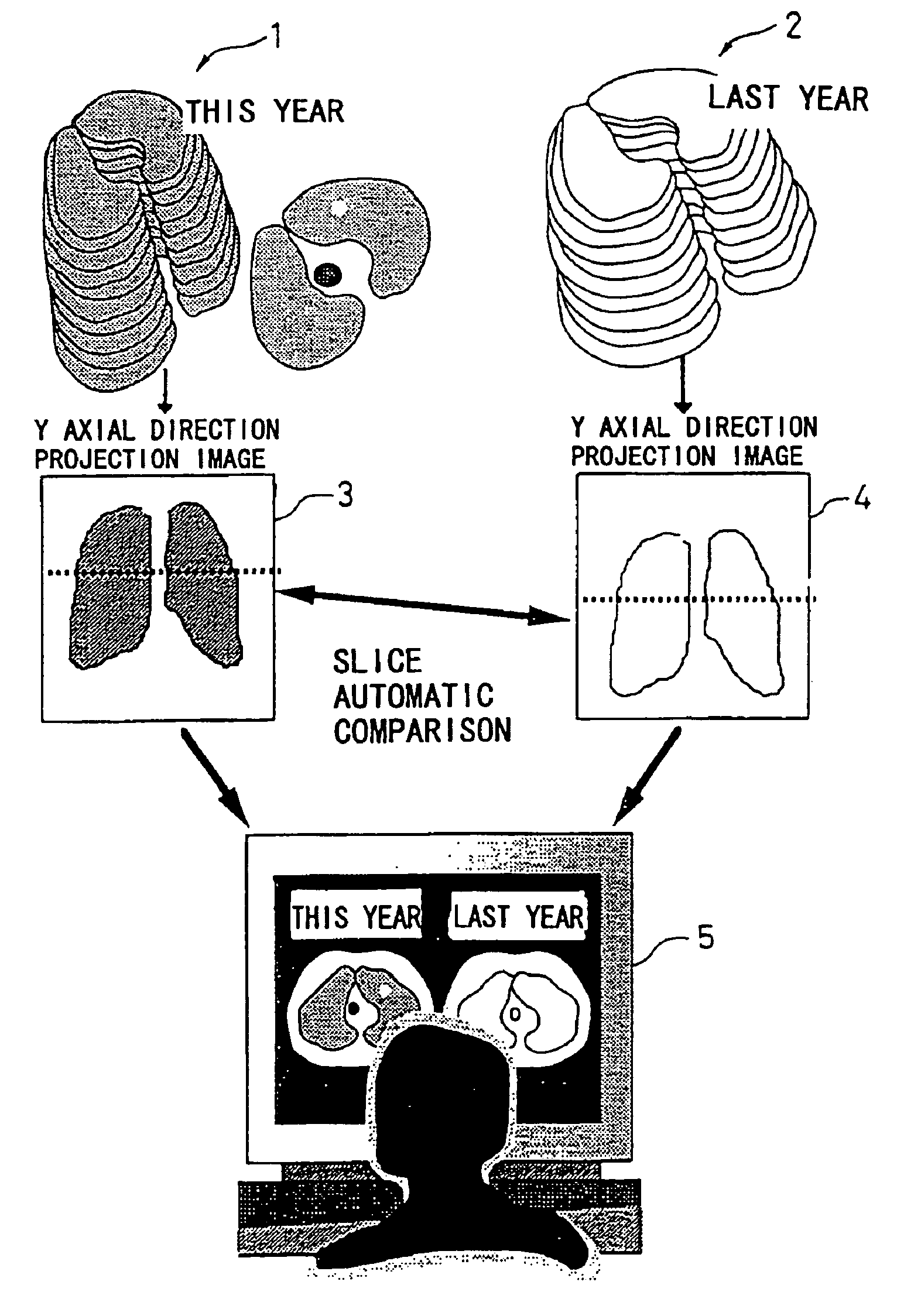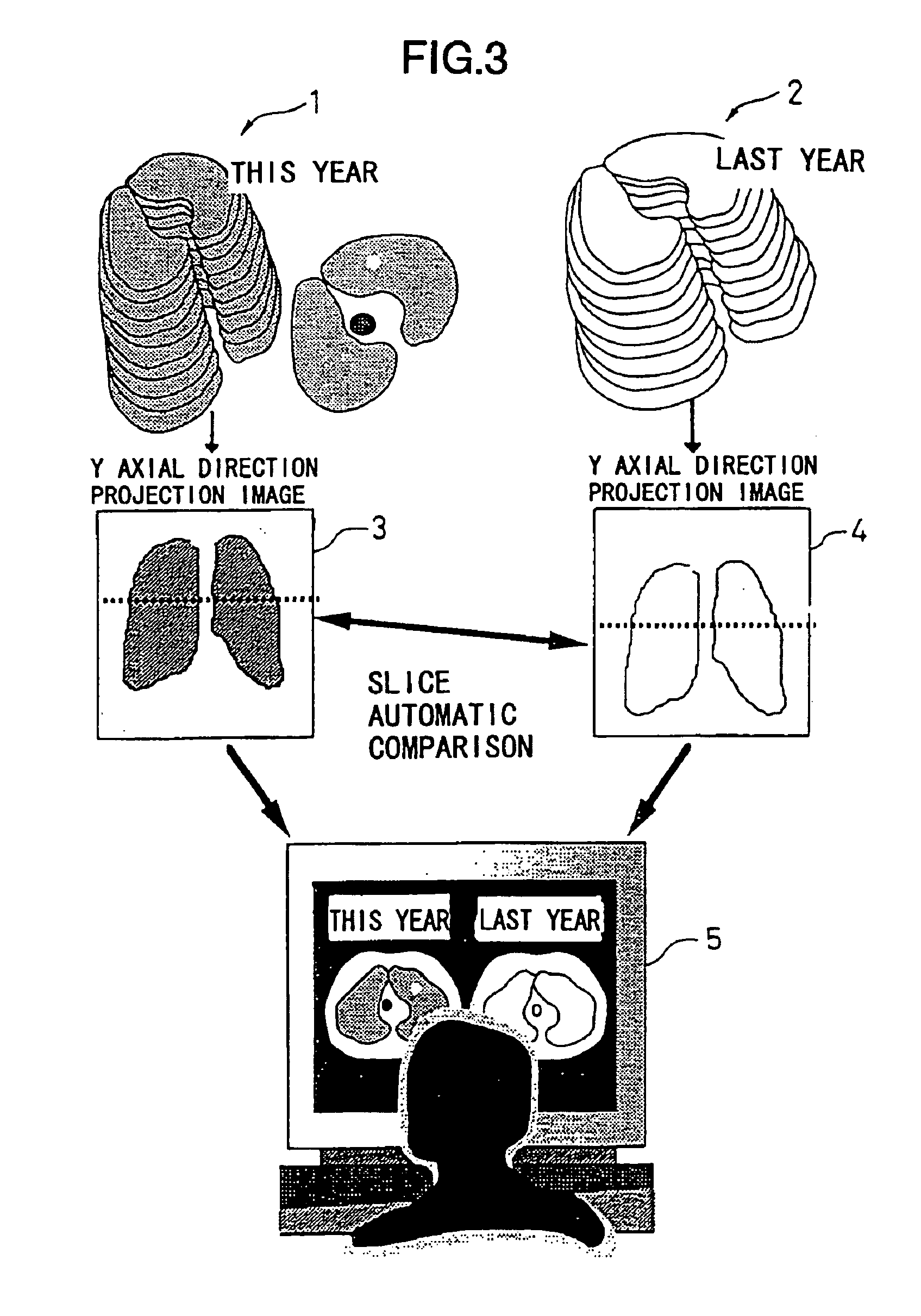Tomographic image reading method, automatic alignment method, apparatus and computer readable medium
- Summary
- Abstract
- Description
- Claims
- Application Information
AI Technical Summary
Benefits of technology
Problems solved by technology
Method used
Image
Examples
first embodiment
[0150]The first embodiment of the present invention will be described.
[0151]FIGS. 1A and 1B are diagrams for explaining X, Y, and Z axes in the chest CT image. Assume that the X-Y axial direction forms a slice plane of a tomographic of body such as chest or the like as shown in FIG. 1B, and that the Z axial direction is a moving direction of a patient bed as shown in FIG. 1A. The chest X ray CT images for lung cancer screening are taken by a helical scan CT shown in FIG. 1A and information of slice thickness in the Z axial direction is included in a slice image of chest tomographic of X-Y axial direction. The number of images to be taken is from 25 to 30 for one person.
[0152]FIGS. 2B and 2C are diagrams showing examples of a projection image. FIG. 2A shows the direction of projection. FIG. 2B is a projection image in which all CT values, which are gray levels, are added in the X axial direction as shown in FIG. 2A. FIG. 2C is a projection image in which all CT values, which are gray...
second embodiment
[0177]Next, the second embodiment of the present invention will be described.
[0178]In the following embodiment, concerning chest X ray CT images for lung cancer screening, it is assumed that present images are compared with previous images.
[0179]The definitions of the X, Y and Z axes are the same as those shown in FIGS. 1A and 1B. That is, the X-Y axial direction forms a slice plane of a tomographic of a body such as chest or the like as shown in FIG. 1B, and the Z axial direction is a moving direction of a patient bed as shown in FIG. 1A. The chest X ray CT images for lung cancer screening are taken by a helical scan CT shown in FIG. 1A and information of slice thickness in the Z axial direction is included in a slice image of chest tomographic of X-Y axial directions. The number of images to be taken is from 25 to 30 for one person.
[0180]FIGS. 9A and 9B are diagrams showing examples of projection. FIG. 9A shows the direction of projection. FIG. 9B is a projection image in which al...
third embodiment
[0194]As shown in FIG. 13B, it is also possible to extract the bed area after generating the projection image. In the flowing, an embodiment in which the bed area is extracted after generating the projection image will be described as the third embodiment.
[0195]FIG. 15 is a block diagram showing an configuration example of the chest CT image alignment apparatus according to the embodiment. The apparatus can be configured as a computer system in the same way as the second embodiment shown in FIG. 10.
[0196]The chest CT image alignment apparatus includes a terminal apparatus 41 to which a tomographic image reading apparatus 42, a mouse 43, a keyboard 44, and a monitor 45 are connected. The terminal apparatus 41 includes an apparatus control part 411 and a slice image automatic alignment function part 412 for tomographic images. The slice image automatic alignment function part 412 for tomographic images includes a slice image automatic alignment function and control part 412-1 for tomo...
PUM
 Login to View More
Login to View More Abstract
Description
Claims
Application Information
 Login to View More
Login to View More - R&D
- Intellectual Property
- Life Sciences
- Materials
- Tech Scout
- Unparalleled Data Quality
- Higher Quality Content
- 60% Fewer Hallucinations
Browse by: Latest US Patents, China's latest patents, Technical Efficacy Thesaurus, Application Domain, Technology Topic, Popular Technical Reports.
© 2025 PatSnap. All rights reserved.Legal|Privacy policy|Modern Slavery Act Transparency Statement|Sitemap|About US| Contact US: help@patsnap.com



